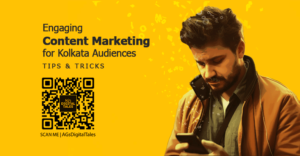
Subscribe to our Blogs
Stay on top of the latest digital marketing tips, trends & best practices.
FREE OF ANY CHARGES • NO CREDIT CARD REQUIRED
Date of Publication: 27 Mar 2023
Are you tired of the traditional sales funnel approach that focuses solely on acquiring new customers? Have you been searching for a more customer-centric approach that can help you increase your revenue and grow your business? Look no further than flywheel marketing. This innovative self-sustaining marketing model is changing the game for businesses of all sizes, and it can do the same for yours. Get a steady stream of leads and prospects for your brand.

Digital Marketing Expert | Media Strategist | Entrepreneur
• These days, people make decisions by asking their friends for advice, searching for mentions of your company on social media, and reading third-party reviews.
• With the flywheel, you use happy customers’ momentum to drive referrals and repeat sales.
• Flywheel helps to find and eliminate friction and get you to rev up you sales by making promoters out of delighted customers.
Flywheel marketing is a customer-centric approach that focuses on delighting customers and turning them into advocates who help drive new leads and customers for business. By putting the customer at the center of everything you do, you can create a virtuous cycle that drives growth and increases revenue. With flywheel marketing, you can rev up your sales and achieve sustainable, long-term growth.
There’s no marketing ploy here. It’s not a jargon debate. There is no rebranding here.
By thinking of your business as a flywheel, you can make different decisions and adjust your strategy accordingly to use the momentum of your happy customers to drive referrals and repeat sales.
Let us first explain how the flywheel works so you can understand what I mean.

The three basic phases of flywheel marketing model are,
Attract → Engage → Delight
In the flywheel marketing model it is not just you who is working towards your business goal. Your delighted clients become your promoters and help you get your business going.
So, how does it work?
Flywheel uses the momentum generated by your delighted cusmoters. The emtire framework depend son three aspects,
• How fast you can spin it
• How much is the friction
• How big is the flywheel
The companies which have successfully implemented the flywheel model for their business have built their strategies to address all three phases.
How can you spin it fasters?
To increase the speed of the flywheel you need to identify which are the areas of impact. You add force to those areas. These forces are,
The team structure is a vital cog in this wheel. You need to realign the internal structure to best suit the framework. Understand the various aspects of why customers are getting stuck at different levels of their journey cycle. You need to understand a few areas with clarity,
When you minimize friction, you increase the speed of the wheel and create more promoters and advocates for your brand. The combined efforts of you and these delighted customers turned promoters will be a combined force that will make the wheel spin on its own.
When you start with a bigger flywheel, it takes much more time to gain top speed. But Once it gains that heavy momentum, it is really hard to stop.
As I have mentioned earlier, the flywheel marketing model given above has three very important phases or spokes. Let us understand them in detail.
In this phase, you attract visitors with useful content and make yourself more available for your customers to know you. The trick here is not to be too assertive to get attention. The forces that you can apply here are
In this phase, you engage and nurture your leads to develop a relationship of trust and convert them to customers. The trick here is not to focus on building relationships and not on closing the deal. The forces you can apply here are,
During my days at B-School, one thing was taught hard – Customer is the King. The king can be your biggest ally when delighted. And if you can get him to do your bidding you become unstoppable.
The success of your customers is your success. At this phase, you help, support and empower your customers. Some forces that can be applied are,
Our data shows that customers are, on average, 37% of the way through a purchase process by the time they reach the solution-definition stage, and 57% of the way through the process before they engage with supplier sales reps.
Havard Business Review
The basic difference between Flywheel Marketing and a Sales Funnel is in their structures. A flywheel marketing model is an ever-rotating circular model, while a funnel is a vertical seeping structure. The flywheel marketing aims to minimize friction between internal structures reducing clumsy handoffs between teams to smoothen customer experience. While in the funnel customer often shuffled from marketing to sales to customer service which could leave the customer irritated and unpleasant. Flywheel marketing is a holistic approach whose sole aim is to improve customer experience.
As per research, referrals and word of mouth superseded everything in the purchase process. A sales funnel does not account for this. A funnel can help you get customers but does not tell you how these converted customers can be delighted to get you more customers.
As per Havard Business Review, in the B2B segment, 57% of purchases are completed before buyers reach out to the vendors. The buyers are no longer looking to first-party information before making a purchase decision. They rely on third-party information, peer-to-peer recommendations, and word of mouth.
As per Micheal Redboard, of Hubspot,
The previous buyer generations used to trust salespeople, check out company case studies, and ask companies to send their customer references. But that does not work anymore, because the buyer generation has changed.
To know more about this, read > Don’t Generalize Buyer Generations – Understand the Defining Traits and Communication Strategy
For the younger generations, the decision-making process has become more involved and research-oriented.
Flywheel being a much-involved customer-focused model, prioritizes the happiness of the customers and sees customers as a channel to help businesses grow.
Let us check out the ways you can drop friction,
Conversion rate optimization will be a continuous process for your business to improve the efficiency of your flywheel. There are a couple of essential components that fall under this so you’ll constantly be looking, trying, and tweaking them as you go.
Make unique CRO tests at relative frequency. See which missions really do best to empower deals or support existing customers or even drive them to refer your business or at least leave happy feedback.
You need to keep a constant watch on different phases of your flywheel and focus on those KPIs and areas of friction that you’ve assessed previously. Try different things with various processes and campaigns that could further give you better results for each stage.
Some model CRO tests for each stage include:
Activate: try testing different touchpoints, viz, landing pages, social media content, etc., and analyze which ones give you more purchases and sign-ups
Adopt: try highlighting different areas so as to get an upsell. e.g you can upsell based on value offering commonly used by hosting providers.
Adore: Experiment with different surveys and feedback from your customers and team.
Advocate: Try different incentive and loyalty programs
Basically, you need to keep up with the improvement game to keep delighting your customers to reach efficiency to add more force to the spinning flywheel.
You must continuously monitor and assess your Flywheel Marketing Model, just like you would with a normal marketing and sales funnel. Take a regular look at the strategies and measurements you established at the start of your campaign(s) and make changes if needed.
The Flywheel Marketing Model has the additional benefit of ensuring a continuous process of acquiring clients, nurturing them, and creating advocates for referrals, which further adds momentum and sustainably increases conversions.
Since momentum is everything, it’s critical to perform a quick litmus test to determine whether you’re achieving your goals and expanding more quickly than before. Ensure client happiness, monitor customer recommendations, examine up-sells and cross-sells, and look for any gaps (i.e, the difference between what you deliver and the expectation of your customers) that can have an impact on your company.
If you have found this blog helpful please like & share
We hope the article helped you understand the topic, but you might still have questions about how it can work for your business / brand. At Tejom Digital, we have built a reputation for answering those tricky questions.
Are you looking to take your business to the next level?
Tejom Digital
is here to help!
Our award-winning digital marketing agency has the expertise and data-driven solutions to ensure optimal reach, engagement, traffic and conversion. With our proven strategies, you can rest assured that your business will be seen by the right people and achieve your desired outcomes. Plus, we offer comprehensive and personalized packages tailored to your specific needs! Let us help you reach your goals today.
FREE OF ANY CHARGES • NO CREDIT CARD REQUIRED







Anirban Guha is an MBA graduate from Amity University, Noida. Starting his career with The Times of India Group, he has spent over 16 years in advertising and has been the founder-director of an award-winning digital marketing agency, Tejom Digital for over 6 years. He has worked with some of the top brands in India and beyond. He is an expert in creative design and digital marketing. He is passionate about helping businesses reach their goals. Beside his professional life, Anirban is an avid reader, a movie buff, a passionate gardener, an art enthusiast, and a foodie.